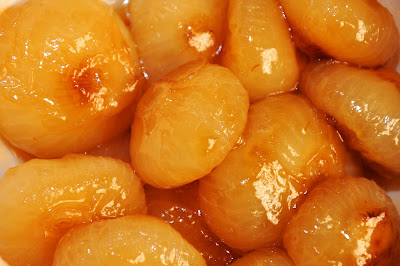If there were an 'all purpose' side dish, this might be it. Cipolline all'agrodolce, also called cipolline in agrodolce, in English 'sweet and sour baby onions', go with just about any meat dish, although it is particularly lovely with roasts. And, the best part is, it is quite simple to make and is even better made ahead.. This is one of those truly indispensable dishes.
There are various ways to make the dish. Here is my favorite method, which is also the simplest:
Peel and trim your onions, then place them in a saucepan. Add enough water to come up, say, halfway up their height, together with some oil, salt and pepper to taste, a pinch of sugar and a dash of white wine vinegar. Allow the onions to simmer gently until the liquid has totally evaporated. At this point, the onion will begin to caramelize as the oil and sugar do their thing. Continue until the oinions are nicely browned and quite tender. Allow the onions to cool a bit before serving; they are also fine at room temperature.
Another method calls for boiling the onions for about 5 minutes in salted water, then browning them in oil (or lard) until brown, then adding the sugar and vinegar and seasonings at the end of their cooking period. This method provides a more assertive sweet and sour flavor.
Yet a third method is a kind of fusion of the two foregoing methods: simmer your onions in water and oil until the water evaporates and the onions are fully cooked. Then add your sugar and vinegar, together with salt and pepper, and until they are well amalgamated.
NOTES: In Italy, the onion to use for this recipe is the somewhat squat onion called, of course, the cipollina. The well-known cipolle di Tropea, especially sweet red onions from Calabria, are also quite good made this way. Cipollina-type onions are now grown in the US and sold in the more upscale markets and, I would assume this is probably true elsewhere. But the same method works for other sorts of small onions, including those very small ones known as 'pearl onions'. You can even use the same methods for frozen baby onions, although the result will not as fine. Fresh onions like green onions (aka scallions) are not really suited, however, to this use.
The 'trick', if there is one, to a successful dish is to balance the sweet and sour tastes so that they balance each other. Ideally, neither should dominate. Since both vinegar and sugar can vary, the best way to make sure you've got the balance right is to taste—but be careful as boiling sugar is very hot. You can also dissolve the sugar into the vinegar before adding them to the dish. This allows you to taste them together while they are still cold.
And personally, I like a rather subtle sweet-sour flavor, which is why I generally add the sugar and vinegar at the beginning rather than at the end of cooking. White wine vinegar is preferably with white onions to avoid discoloration, but red wine vinegar will do fine as well. As for the sugar, I particularly like brown sugar, which caramelizes more readily than white, refined sugar. I have even used honey with good results. But there is room here to vary the type and amount of both ingredients to suit your own taste and imagination.
The only real difficult part with this dish is the initial preparation of the onions for cooking. Of course, the smaller the onion, the fussier the preparation will be. In Italy, cipolline are often sold ready to cook, but not where I live now. To prepare an onion for cooking, you peel it, using a sharp paring knife, starting from the tip and moving to the root. You then trim off a bit of the base and cut a cross into it to aid even cooking. The peeling can be made considerably easier by blanching your unpeeled onions for about a minute just before peeling. Run under cold water for a moment so the onions will be cool enough to handle, then peel them while they are still warm. The skin should slip off easily.
Besides onions, carrots are very nice made this way. In Sicily, zucca (Italian pumkin) is also made in agrodolce, with the addition of raisins and mint. In summer, peppers can also be made in agrodolce by sautéing them in oil with a bit of garlic and, when they are nearly done, adding vinegar and sugar. Zucchine can also be made in a very similar way. In Italian Jewish cookery, braised cabbage is made in agrodolce by adding vinegar, sugar and raisins, softened in lukewarm water, at the end of cooking.
